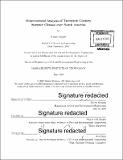Observational analysis of twentieth century summer climate over North America
Author(s)
Douglas, Hunter (Hunter Callum)
DownloadFull printable version (18.27Mb)
Other Contributors
Massachusetts Institute of Technology. Department of Civil and Environmental Engineering.
Advisor
Elfatih A.B. Eltahir.
Terms of use
Metadata
Show full item recordAbstract
How did the climate of the central United States change over the course of the twentieth century? In this study, multiple complementary statistical analyses were carried out on weather and agricultural production data in order to determine the spatiotemporal nature of changes. Variables considered included: precipitation, air temperature, air pressure, humidity, and evapotranspiration, as well as acreage, yield, and production of major crops. The study focused primarily on changes in July and August climate in the Midwest and Great Plains, home to the majority of agricultural production in the U.S. Statistically significant and sustained increases in summer precipitation and decreases in summer temperature were observed in the Midwest, with the changes centered on the period 1950-1970. Evidence was also observed for increases in specific humidity and evapotranspiration over the century. These changes were collated in space and time with rapid increases in photosynthetic activity through increased crop production and yield. The study thus lays the ground for future research in attributing the causes of regional climate change, especially through the interactions of climate and land use.
Description
Thesis: M. Eng., Massachusetts Institute of Technology, Department of Civil and Environmental Engineering, 2016. Cataloged from PDF version of thesis. Includes bibliographical references (pages 66-68).
Date issued
2016Department
Massachusetts Institute of Technology. Department of Civil and Environmental EngineeringPublisher
Massachusetts Institute of Technology
Keywords
Civil and Environmental Engineering.